Besatzungen der ISS
![]()
ISS: Expedition 29 |
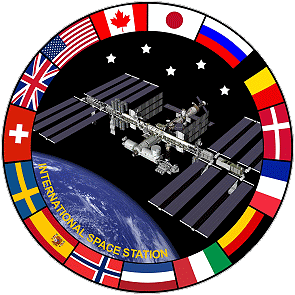 |
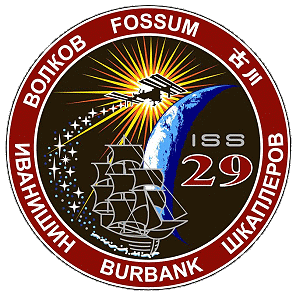 |
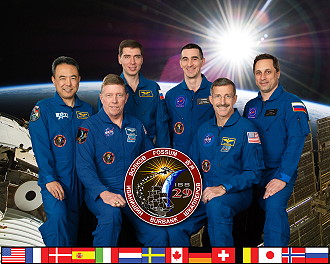 |
alternatives Crewfoto |
|
 |
|
![]()
Besatzung, Start- und Landedaten
| Nr. | Nation | Name | Vorname | Position | Raumschiff (Start) |
Startdatum | Startzeit | Raumschiff (Landung) |
Landedatum | Landezeit | Flugdauer | Erdorbits |
| 1 | Fossum | Michael Edward | ISS-CDR | Sojus TMA-02M | 07.06.2011 | 20:12:44,924 UTC | Sojus TMA-02M | 22.11.2011 | 02:24:50 UTC | 167d 06h 12m 05s | 2614 | |
| 2 | Schkaplerow | Anton Nikolajewitsch | Bordingenieur-1 | Sojus TMA-22 | 14.11.2011 | 04:14:03,953 UTC | Sojus TMA-22 | 27.04.2012 | 11:45:35,2 UTC | 165d 07h 31m 31s | 2580 | |
| 3 | Iwanischin | Anatoli Alexejewitsch | Bordingenieur-2 | Sojus TMA-22 | 14.11.2011 | 04:14:03,953 UTC | Sojus TMA-22 | 27.04.2012 | 11:45:35,2 UTC | 165d 07h 31m 31s | 2580 | |
| 4 | Burbank | Daniel Christopher | Flugingenieur-3 | Sojus TMA-22 | 14.11.2011 | 04:14:03,953 UTC | Sojus TMA-22 | 27.04.2012 | 11:45:35,2 UTC | 165d 07h 31m 31s | 2580 | |
| 5 | Wolkow | Sergej Alexandrowitsch | Bordingenieur-4 | Sojus TMA-02M | 07.06.2011 | 20:12:44,924 UTC | Sojus TMA-02M | 22.11.2011 | 02:24:50 UTC | 167d 06h 12m 05s | 2614 | |
| 6 | Furukawa | Satoshi | Flugingenieur-5 | Sojus TMA-02M | 07.06.2011 | 20:12:44,924 UTC | Sojus TMA-02M | 22.11.2011 | 02:24:50 UTC | 167d 06h 12m 05s | 2614 |
inoffizielle Ersatzmannschaft
| Nr. | Nation | Name | Vorname | Position |
| 1 | Pettit | Donald Roy | ISS-CDR | |
| 2 | Padalka | Gennadi Iwanowitsch | Bordingenieur | |
| 3 | Rewin | Sergej Nikolajewitsch | Bordingenieur | |
| 4 | Acaba | Joseph Michael | Flugingenieur | |
| 5 | Kononenko | Oleg Dmitrijewitsch | Bordingenieur | |
| 6 | Kuipers | André | Flugingenieur |
 |
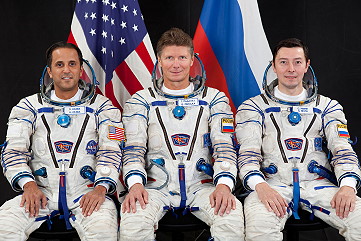 |
 |
Expeditionsverlauf
|
Start vom Kosmodrom Baikonur (Anton
Schkaplerow, Anatoli
Iwanischin und Daniel
Burbank mit
Sojus
TMA-22). Sergej
Wolkow, Michael
Fossum und Satoshi
Furukawa waren seit dem 09. Juni 2011 an Bord der Raumstation
(Ankunft mit Sojus TMA-02M). Die ISS Expedition 29 begann mit der Abkopplung des russischen Raumschiffs Sojus TMA-21 am 16. September 2011 um 00:38:12 UTC, das die vorhergehende Stationsbesatzung (Alexander Samokutajew, Andrej Borissenko und Ronald Garan) zurück zur Erde brachte. Ursprünglich sollte der zweite Teil der Mannschaft (Anton Schkaplerow, Anatoli Iwanischin und Daniel Burbank) am 22. September 2011 mit Sojus TMA-22 starten. Nach der Fehlzündung der dritten Stufe der Sojus-U-Rakete von Progress M-12M am 24. August 2011 wurde die Mission in den November 2011 verschoben, um zuerst die Ursache des Fehlstarts ermitteln zu können. Der Start erfolgte schließlich am 14. November 2011, das Raumschiff dockte am 16. November 2011 an der Raumstation an. Michael Fossum, Satoshi Furukawa und Sergej Wolkow blieb nur eine knappe Woche, die ISS an ihre Kollegen Daniel Burbank, Anton Schkaplerow und Anatoli Iwanischin zu übergeben, da die Landung von Sojus TMA-02M aufgrund widriger Wetter- und Tageslichtbedingungen am Landeplatz in Kasachstan nicht nach dem 22. November 2011 erfolgen konnte. Um die Übergabe zu unterstützen, hatte die Crew von Sojus TMA-02M eine Serie von Videos angefertigt, die der Crew von Sojus TMA-22 den gegenwärtigen Zustand der ISS erklärte. Der unbemannte russische Frachter Progress M-13M legte am 02. November 2011 um 11:41 UTC an der Internationalen Raumstation an. Er war am 30. Oktober 2011 um 10:11 UTC vom Kosmodrom Baikonur gestartet. Das Transport-Raumschiff brachte 2,9 Tonnen Lebensmittel, Treibstoff und sonstige Ausrüstungsgegenstände, darunter 750 kg Treibstoff, 50 kg Sauerstoff, 420 kg Wasser und 1.410 kg Ersatzteile, Hardware für Experimente und persönliche Gegenstände zur Stammbesatzung. Am 23. Januar 2012 um 22:10 UTC koppelte Progress M-13M wieder ab und brachte danach einen kleinen Satelliten auf eine Umlaufbahn. Der Frachter wurde kontrolliert zum Absturz gebracht und verglühte am 25. Januar 2012 über dem Pazifischen Ozean. Nach der Übergabe des Kommandos über die Internationale Raumstation von dem amerikanischen Astronauten Michael Fossum an den amerikanischen Astronauten Daniel Burbank legte das Raumschiff Sojus TMA-02M am 21. November 2011 um 23:00:17 UTC mit Sergej Wolkow, Michael Fossum und Satoshi Furukawa an Bord von der Station ab. Die Expedition 29 der ISS war damit beendet und es begann die ISS Expedition 30. Während ihres Aufenthaltes an Bord der ISS führten die Crews der Expeditionen 29 / 30 folgende wissenschaftliche Experimente durch (vollständige Auflistung): 2D-NanoTemplate (Production of Two Dimensional NanoTemplate in Microgravity), 3DA1 Camcorder (Panasonic 3D Camera), ALTEA-Dosi (Anomalous Long Term Effects in Astronauts' - Dosimetry), ALTEA-GAP (Anomalous Long Term Effects in Astronauts' Central Nervous System-GAP), ALTEA-Shield (Anomalous Long Term Effects in Astronauts' Central Nervous System - Shield), AMS-02 (Alpha Magnetic Spectrometer - 02), Actiwatch Spectrum (Actiwatch Spectrum System), Alloy Semiconductor (Crystal Growth of Alloy Semiconductor Under Microgravity), Amine Swingbed (Amine Swingbed), Aquatic Habitat (Aquatic Habitat), Area PADLES (Passive Dosimeter for Lifescience Experiment in Space), AuroraMAX (Coordinated Aurora Photography from Earth and Space (AuroraMAX)), BASS (Burning and Suppression of Solids), BCAT-3-4-CP (Binary Colloidal Alloy Test - 3 and 4: Critical Point), BCAT-4-Poly (Binodal Colloidal Aggregation Test - 4: Polydispersion), BCAT-5-3D-Melt (Binary Colloidal Alloy Test - 5: Three-Dimensional Melt), BCAT-5-PhaseSep (Binary Colloidal Alloy Test-5: Phase Separation), BCAT-5-Seeded Growth (Binary Colloidal Alloy Test - 5: Seeded Growth), BCAT-6-Colloidal Disks (Binary Colloidal Alloy Test - 6 - Colloidal Disks), BCAT-6-PS-DNA (Binary Colloidal Alloy Test - 6: Polystyrene - Deoxyribonucleic Acid), BCAT-6-Phase_Separation (Binary Colloidal Alloy Test - 6 - Phase Separation), BCAT-6-Seeded Growth (Binary Colloidal Alloy Test - 6: Seeded Growth), BioLab (Biological Experiment Laboratory), Biological Rhythms (The Effect of Long-term Microgravity Exposure on Cardiac Autonomic Function by Analyzing 24-hours Electrocardiogram), Bisphosphonates (Bisphosphonates as a Countermeasure to Space Flight Induced Bone Loss), CCF (Capillary Channel Flow), CEO (Crew Earth Observations), CEVIS (Cycle Ergometer with Vibration Isolation and Stabilization System), CFE-2 (Capillary Flow Experiment - 2), CIR (Combustion Integrated Rack - Fluids and Combustion Facility), COLBERT (Combined Operational Load Bearing External Resistance Treadmill), CSI-05 (Commercial Generic Bioprocessing Apparatus Science Insert - 05: Spiders, Fruit Flies and Directional Plant Growth), Card (Long Term Microgravity: A Model for Investigating Mechanisms of Heart Disease with New Portable Equipment), CsPINs (Dynamism of Auxin Efflux Facilitators, CsPINs, Responsible for Gravity-regulated Growth and Development in Cucumber), DECLIC-ALI (DEvice for the study of Critical LIquids and Crystallization - Alice Like Insert), DECLIC-DSI (DEvice for the study of Critical LIquids and Crystallization - Directional Solidification Insert), DECLIC-HTI (DEvice for the study of Critical LIquids and Crystallization - High Temperature Insert), DOD-SPHERES-CSAC (Department of Defense Synchronized Position, Hold, Engage, Reorient, Experimental Satellites-Chip Scale Atomic Clock), DTN (Disruption Tolerant Networking for Space Operations), Dynamic Surf (Experimental Assessment of Dynamic Surface Deformation Effects in Transition to Oscillatory Thermo capillary Flow in Liquid Bridge of High Prandtl Number Fluid), EDOS (Early Detection of Osteoporosis in Space), EDR (European Drawer Rack), EKE (Assessment of Endurance Capacity by Gas Exchange and Heart Rate Kinetics During Physical Training), EMCS (European Modular Cultivation System), EPM (European Physiology Module), EPO-Demos (Education Payload Operation - Demonstrations), ERB-2 (Erasmus Recording Binocular - 2), ESA-EPO (European Space Agency - Education Payload Operations), ESA Nodding Mechanism (ESA Nodding Mechanism), EXPRESS Racks (EXpedite the PRocessing of Experiments for Space Station Racks), EarthKAM (Earth Knowledge Acquired by Middle School Students), FIR (Fluids Integrated Rack - Fluids and Combustion Facility), LEX (Flame Extinguishment Experiment), LEX-2 (Flame Extinguishment Experiment - 2), FSL (Fluid Science Laboratory), Functional Task Test (Physiological Factors Contributing to Changes in Postflight Functional Performance), GLACIER (General Laboratory Active Cryogenic ISS Experiment Refrigerator), Geoflow-2 (Simulation of Geophysical Fluid Flow Under Microgravity - 2), HET-Smartphone (Human Exploration Telerobotics Smartphone), HREP-HICO (HICO and RAIDS Experiment Payload - Hyperspectral Imager for the Coastal Ocean), HREP-RAIDS (HICO and RAIDS Experiment Payload - Remote Atmospheric and Ionospheric Detection System (RAIDS)), HRF-1 (Human Research Facility - 1), HRF-2 (Human Research Facility - 2), Hair (Biomedical Analyses of Human Hair Exposed to a Long-term Space Flight), Hicari (Growth of Homogeneous SiGe Crystals in Microgravity by the TLZ Method), ISERV (ISS SERVIR Environmental Research and Visualization System), ISSAC (International Space Station Agricultural Camera), ISS Ham Radio (International Space Station Ham Radio), Ice Crystal 2 (Crystal growth mechanisms associated with the macromolecules adsorbed at a growing interface - Microgravity effect for self-oscillatory growth - 2), Immuno (Neuroendocrine and Immune Responses in Humans During and After Long Term Stay at ISS), InSPACE-3 (Investigating the Structure of Paramagnetic Aggregates from Colloidal Emulsions - 3), Integrated Cardiovascular (Cardiac Atrophy and Diastolic Dysfunction During and After Long Duration Spaceflight: Functional Consequences for Orthostatic Intolerance, Exercise Capability and Risk for Cardiac Arrhythmias), Integrated Immune (Validation of Procedures for Monitoring Crewmember Immune Function), JAXA-Commercial (Japan Aerospace Exploration Agency - Commercial Payload Program), JAXA EPO 7 (Japan Aerospace Exploration Agency Education Payload Observation 7), JAXA EPO 8 (Japan Aerospace Exploration Agency Education Payload Observation 8), JAXA PCG (Japan Aerospace Exploration Agency Protein Crystal Growth), Journals (Behavioral Issues Associated with isolation and Confinement: Review and Analysis of Astronaut Journals), Kubik (Kubik), LEGO Bricks (LEGO® Bricks, formerly known as NLO-Education-2), MAMS (Microgravity Acceleration Measurement System), MARES (Muscle Atrophy Research and Exercise System), MAXI (Monitor of All-sky X-ray Image), MCE (Multi-mission Consolidated Equipment), MELFI (Minus Eighty-Degree Laboratory Freezer for ISS), MERLIN (Microgravity Experiment Research Locker Incubator), MFMG (Miscible Fluids in Microgravity), MISSE-8 (Materials International Space Station Experiment - 8), MSG (Microgravity Science Glovebox), MSL-CETSOL and MICAST (Materials Science Laboratory - Columnar-to-Equiaxed Transition in Solidification Processing and Microstructure Formation in Casting of Technical Alloys under Diffusive and Magnetically Controlled Convective Conditions), MSRR-1 (Materials Science Research Rack-1), Marangoni-Exp (Chaos, Turbulence and its Transition Process in Marangoni Convection-Exp), Myco-3 (Mycological Evaluation of Crew Exposure to ISS Ambient Air - 3), NanoRacks-CubeLabs Platforms (NanoRacks-CubeLabs Platforms), NanoRacks-E-Book (NanoRacks-Electronic-Book), NanoRacks-FCA-Concrete Mixing (NanoRacks-Faith Christian Academy-Concrete Mixing Experiment), NanoRacks-FCHS-Robot (NanoRacks-Fremont Christian High School-Mini-Robot), NanoRacks-Fischer-18S-rRNA (NanoRacks-Fischer Institute of Air and Space-Footsteps of Creation and Origin of Life), NanoRacks-Fischer-Bone (NanoRacks-Fischer Institute of Air and Space-Bone Study), NanoRacks-Fischer-Early Development (NanoRacks-Fischer Institute of Air and Space-Early Development), NanoRacks-Fischer-Milk (NanoRacks-Fischer Institute of Air and Space-Probiotic Milk), NanoRacks-NanoKit-1 (NanoRacks-DreamUP!-Crystal Microplates-NanoKit-1), NanoRacks-Smartphone-2 (NanoRacks-Smartphone-2), NanoRacks-Terpene (NanoRacks-Terpene Extraction in Microgravity), NanoRacks-VCHS-B. Sphaericus (NanoRacks-Valley Christian High School- Bacillus Sphaericus Bacteria Growth), NanoRacks-VCHS-Electromagnetic Ferrofluid (NanoRacks-Valley Christian High School-Electromagnetic Effects on Ferrofluid), NanoRacks-VCHS-Electroplating (NanoRacks-Valley Christian High School-Electroplating), NanoRacks-VCHS-Plant Growth (NanoRacks-Valley Christian High School-Plant Growth), NanoRacks-VCHS-To Be Selected (NanoRacks-Valley Christian High School-To Be Selected Experiment), NanoRacks-WCHS-E. Coli and Kanamycin (NanoRacks-Whittier Christian High School-E.Coli Bacteria and Kanamycin Antibiotic), NanoRacks Plate Reader (NanoRacks Plate Reader), Nano Step (In-situ Observation of Growth Mechanisms of Protein Crystals and Their Perfection Under Microgravity), Neurospat (Effect of Gravitational Context on EEG Dynamics: A Study of Spatial Cognition, Novelty Processing and Sensorimotor Integration), Nutrition (Nutritional Status Assessment), Onboard Diagnostic Kit (Evaluation of Onboard Diagnostic Kit), PACE-2 (Preliminary Advanced Colloids Experiment - 2: 3D Particle Test), Particle Flux (Particle Flux Demonstrator), Passages (Scaling Body-Related Actions in the Absence of Gravity), Photosynth (Photosynth™ Three-Dimensional Modeling of ISS Interior and Exterior), Pro K (Dietary Intake Can Predict and Protect Against Changes in Bone Metabolism during Spaceflight and Recovery, REBR (ReEntry Breakup Recorder), ROALD-2 (ROle of Apoptosis in Lymphocyte Depression-2), RRM (Robotic Refueling Mission), Reaction Self Test (Psychomotor Vigilance Self Test on the International Space Station), Repository (National Aeronautics and Space Administration Biological Specimen Repository), Robonaut (Robonaut), Ryutai (Ryutai Experiment Rack), SAMS-II (Space Acceleration Measurement System-II), SATS-Interact (Supervision of Autonomous and Teleoperated Satellites - Interact), SCAN Testbed (Space Communications and Navigation Testbed), SEDA-AP (Space Environment Data Acquisition Equipment - Attached Payload), SLICE (Structure and Liftoff In Combustion Experiment), SMILES (Superconducting Submillimeter-Wave Limb-Emission Sounder), SNFM (Serial Network Flow Monitor), SODI-Colloid-2 (SODI-Colloid-2), SODI-DSC (Selectable Optical Diagnostics Instrument - Diffusion and Soret Coefficient), SOLO (SOdium LOading in Microgravity), SPHERES (Synchronized Position Hold, Engage, Reorient, Experimental Satellites), SPHERES-Zero-Robotics (Synchronized Position Hold, Engage, Reorient, Experimental Satellites-Zero-Robotics), SS-HDTV (Super-Sensitive High Definition TV), STP-H3-Canary (Space Test Program - Houston 3 - Canary), STP-H3-DISC (Space Test Program - Houston 3 - Digital Imaging Star Camera), STP-H3-MHTEX (Space Test Program - Houston 3 - Massive Heat Transfer Experiment), STP-H3-VADER (Space Test Program - Houston 3 - Variable emissivity radiator Aerogel insulation blanket Dual zone thermal control Experiment suite for Responsive space), Saibo (Saibo Experiment Rack), Solar-SOLACES (Sun Monitoring on the External Payload Facility of Columbus - SOLar Auto-Calibrating EUV/UV Spectrophotometers), Solar-SOLSPEC (Sun Monitoring on the External Payload Facility of Columbus -Sun Monitoring on the External Payload Facility of Columbus -SOLar SPECtral Irradiance Measurements), SpaceDRUMS (Space Dynamically Responding Ultrasonic Matrix System), Space Headaches (Space Headaches), Spin (Validation of Centrifugation as a Countermeasure for Otolith Deconditioning During Spaceflight), Sprint (Integrated Resistance and Aerobic Training Study), TEM (Transport Environment Monitor Packages), Thermolab (Thermoregulation in Humans During Long-Term Spaceflight), Tomatosphere-III (Tomatosphere-III), Treadmill Kinematics (Biomechanical Analysis of Treadmill Exercise on the International Space Station), UMS (Urine Monitoring System), Ultrasound 2 (Human Research Facility Ultrasound on the International Space Station 2), VIABLE ISS (eValuatIon And monitoring of microBiofiLms insidE International Space Station), VO2max (Evaluation of Maximal Oxygen Uptake and Submaximal Estimates of VO2max Before, During, and After Long Duration International Space Station Missions), Vascular (Cardiovascular Health Consequences of Long-Duration Space Flight), Vessel ID System (Vessel ID System), Vessel Imaging (Vascular Echography), WORF (Window Observational Research Facility), You Tube Space Lab (You Tube Space Lab). |
Aufbau der ISS
 |
 |
 |
Fotos
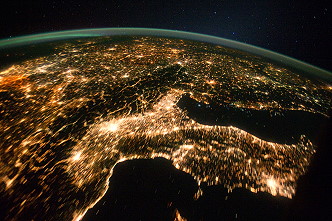 |
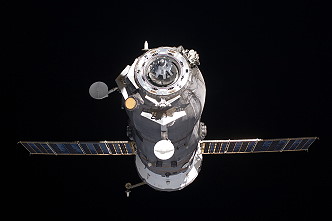 |
 |
 |
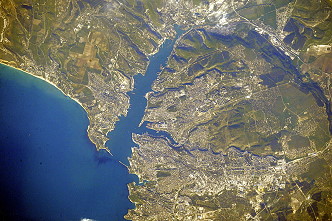 |
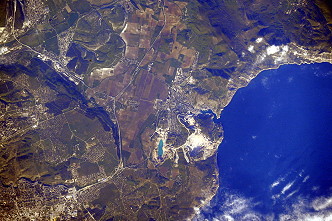 |
 |
|
mehr Fotos Erdbeobachtung |
|
mehr Fotos von Bord der ISS |
|
| © |  |
Letztes Update am 10. November 2023.  |
 |